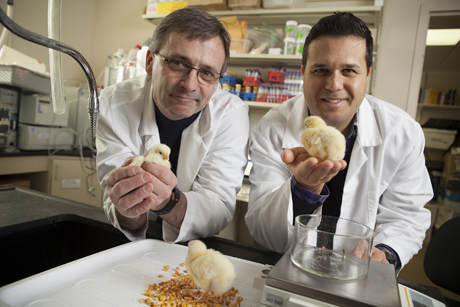Iron in new maize strain gets absorbed more readily
By Luda Shtessel

Researchers at Cornell have developed a strain of maize with a high iron bioavailability, meaning more of the iron that is present naturally in these maize lines can be absorbed.
The researchers, all from the U.S. Department of Agriculture - Agricultural Research Service's Robert Holley Center on the Cornell campus, tested more than 100 maize strains for differences in iron bioavailability. They did this by introducing simulated digestions of the individual maize strains to cultured human intestinal cells and measuring the iron bioavailability. Using a technique known as quantitative trait loci (QTL) mapping, they correlated this measure with areas of the maize genome, which helped guide the maize breeding.
Iron deficiency is the most prevalent nutritional deficiency and cause of anemia in the world. Although boosting the nutritional quality of iron in staple food crops can help, increasing iron concentrations in the crop does not guarantee increased iron absorption.
"We had two options: to increase the concentration or to increase the bioavailability. Our maize breeder, Dr. Owen Hoekenga [a Cornell molecular biologist], chose to select for iron bioavailability as these regions appeared more easy to isolate," said food scientist Elad Tako, lead author of the study, which was published in the January issue of Nutrition Journal (12:20).
The results were validated by feeding the new maize, which harbored three QTLs predicted to promote iron bioavailability, to chickens. A diet of maize with high iron bioavailability maintained the iron status of chickens, but chickens fed the low bioavailable iron maize became anemic.
"While the up-front cost of improving the iron quality of staple foods is high, the cost of maintaining them is likely less and thus very sustainable," said food scientist Raymond Glahn, the senior author of the study.
As part of the study, the researchers developed techniques to test the results of the cell culture assay in a live animal -- in this case, the broiler chicken. Such a model is "cost-effective, easy to handle, sensitive to dietary mineral deficiencies, including iron, and could consume the broad range of staple crops that we plan to test," said Tako.
In the future, the researchers hope to identify QTLs that govern the availability of other vital nutrients in crops. "We have done a lot with beans, lentils, sorghum, wheat -- looking into factors that can affect the bioavailability of iron, but we are also interested in zinc bioavailability," said Tako.
"Biofortification of grains with iron and zinc not only gives better nutrition for the consumers but it's also an incentive for the farmers because they promote crop yield. Without that feature, the farmers wouldn't adopt it," said Glahn.
The World Health Organization reports that almost a quarter of the world's population is anemic, with prevalence rates at almost 70 percent in African countries, where maize is an integral part of the diet. "The ultimate game is to take this to an area where the population is iron-deficient," said Glahn, in hopes of curbing anemia.
However, "large-scale feeding studies in humans can be costly ... So before we can plan such a study, we must confirm that our enhanced maize can provide more bioavailable iron to humans. This will involve human volunteers … and would likely be performed here on the Cornell campus," said Glahn.
Plant biologist Leon Kochian was also a co-author of the study, which was funded by the USDA. All the co-authors also have courtesy academic appointments at Cornell.
Luda Shtessel is a postdoctoral associate in Cornell's Department of Molecular Biology and Genetics.
Media Contact
Get Cornell news delivered right to your inbox.
Subscribe